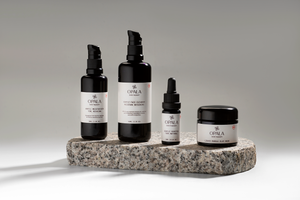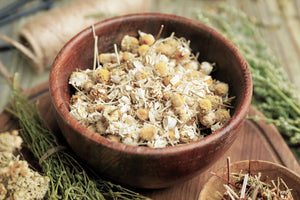
Help your skin change with age - a guide to healthy ageing
Our skin’s health is considered one of the more prominent factors in how our overall wellbeing is perceived by ourselves and others. And with this, it becomes an important factor in feeling confident over our lifetime.
While the natural process of ageing starts early around the age of 25, visible signs are mostly masked inside our bodies, inside organs. Our skin on the other hand, provides the first obvious mark of the passing of time. This normally accelerates after another 25 years, particularly around menopause in women.
The process is irreversible. But not unmanageable. Through caring for your skin’s health in an informed, and regimented way, your skin can remain vibrant and alluring at any age. This guide aims to cover all you need to know about how your skin changes with age, and how you can help age with grace. Remember, it is never too late to start taking the right step.
The ageing process combines a number of factors
Like a number of other organs, our skin’s process of ageing is not only a result of the body’s natural ‘wear and tear’, but also one that is influenced by external factors. The combination of factors includes our inherited genetics, overall health, lifestyle, exposure to UV, nutrition, etc.
These factors together lead to a number of structural and physiological changes in each layer of the skin, compounding to create a change in appearance.
The figure below summarises the key factors contributing towards ageing. Those marked grey cannot be influenced in most cases, and certainly not without medical intervention. But the factors marked in colour can! This is where we continue our focus.

These factors lead to a number of changes
During the ageing process, we experience changes to all three layers of our skin. The epithelium (epidermis) becomes thinner and begins to lose its water-binding capacity. The amount of collagen and elastin in the skin (dermis) decreases, accompanied by a fall in the amount of hyaluronic acid, further reducing moisture retention, and oil balance. In the subcutaneous tissue (subcutis below the dermis), the area covered by fat pads (closely packed fat cells) decreases, weakening the connective tissue in this layer.

DRYNESS - As the number of sweat and oil glands reduces, the skin becomes dryer, and begins to lose some of its elasticity and tone. This is often accompanied by peeling skin and itching.
THINNING - The basal cell layer of the epidermis slows its rate of cell production, thinning the layer. The dermis may also become thinner. Together these changes increase the likelihood of the skin to wrinkle.
SAGGING - With less elasticity and collagen, older skin is particularly vulnerable to forces it is exposed to (like gravity or other stress). This can cause the skin to sag and droop, for example creating jowls along the jaw and bags under the eyes.
WRINKLES - In addition to thinning, the process of ageing reduces elasticity and collagen, leading to lines and wrinkles. This is predominantly the case in highly active areas of the face, like around the eyes and the mouth.
AGE SPOTS - The remaining pigment cells (melanocytes) tend to increase in number and cluster in certain areas, forming what’s known as age or liver spots. Areas that have been exposed to the sun, such as the backs of the hands, are particularly prone to age spots.
BROKEN BLOOD VESSELS - Blood vessels are also more likely to break and bruise in thinner skin, and can become permanently widened.
There are steps you can take to help your skin age
The following steps can significantly help your skin along the process of ageing, sustaining a firmer and more vibrant complexion.
1. SUNPROTECTION AND SYSTEMIC ANTIOXIDANTS
Sun exposure (in particular UV exposure) accelerates the ageing process. If you want proof, compare the skin on your hand with that on your back (or even your buttocks). There are a number of approaches to protecting your skin from sun damage throughout your life, from sun avoidance and UV protection, to using anti-oxidants to reduce and neutralise free radicals. The former is a well known tip – avoid high UV exposure and apply sun protection (ideally a natural, or actively skin-balanced cream). The latter is often overlooked. The most important source of antioxidants should be provided by nutrition. Starting with the most efficient systemic antioxidants, such as Vitamins C & E, carotenoids, to elements such as copper and selenium.
2. SKIN BARRIER PROTECTION
A healthy and functioning skin barrier is a vial prerequisite against dehydration, the penetration of microorganisms, allergens, irritants and radiation. Applying a suitable daily skincare regime enhanced the functioning of the skin barrier, increasing skin regeneration, elasticity, and smoothness. Learn more about the skin barrier protection here.
3. ANTI-AGEING CREAMS
A more obvious one since it is in the name! But there are two main groups of agents that can be used as anti-ageing cream components: the antioxidants, and the cell regulators.
The antioxidants, as described above are vitamins, polyphenols and flavonoids. They reduce collagen degradation by lowering the concentration of free radicals in the tissues. Vitamins C, B3, and E are the most important antioxidants because of their ability to penetrate the skin through their small molecular weight.
We recommend using natural plant-derived antioxidants for an enhanced, and highly concentrated effect (e.g. a comprehensive all-round antioxidant, Opala's Anti-Oxi Moisturiser )
Cell regulators, such as vitamin A derivatives, polypeptides and botanicals (like Bakuchiol), act directly to influence collagen metabolism and stimulate the production of collagen and elastic fibres. Many antioxidants and cell regulators are best absorbed overnight when the skin works on repair, and we recommend a comprehensive, natural solution that combines both of these agents (e.g. Opala’s Restorative Night Serum.)
4. LIFE STYLE AND HABITS
Healthy lifestyle choices can help minimise the signs of both ageing. An important part of this is a healthy diet, regular nonstrenuous exercise, and above all, plenty of hydration (at least two litres of water a day).
Note that there are of course a range of medical and surgical anti-ageing treatments that are available in addition to preventative measures, like the ones listed in this blog. These medical interventions are not without risk. Ensure that you have realistic expectations of the potential benefits and limitations of both preventative and medical solutions, and understand the potential risks, and complications of the latter.



